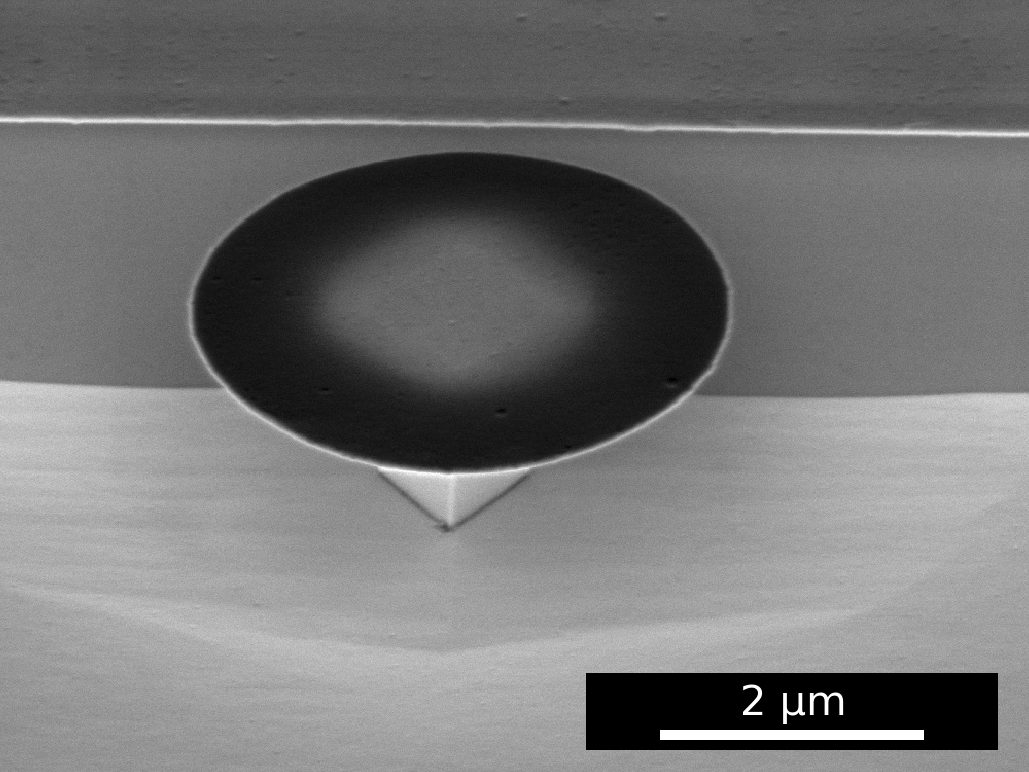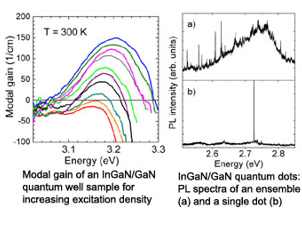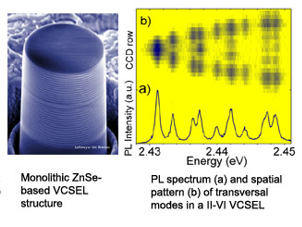Semiconductor nanostructures with wide bandgap


Mikrodisk resonators based on II-VI semiconductors
In microdisks, light can propagate in so-called "Whispering Gallery Modes" along the border of the resonator and confined like this. This phenomenon can be used to create laser emission in these structures with low-energetic input. Another possible application lies in quantum technologies. Here Qubits need to be saved; this can for example be done in atomic spins that can be incoporated into the microdisk and controlled by the confined light.
In both cases the strength of light containment is decisive. The reflection of light at the resonator's sidewall is larger, if it is smooth. In our current measurements of such resonators we are testing, if smooting a microdisk with a focussed ion beam can improve the properties of the resonator for application.
ZnSe based nanostructures and devices
Selenide based wide-bandgap semiconductors are also well suited for the realization of optoelectronic devices for the blue to green spectral region operating at room temperature. This material system is characterized by large oscillator strengths and excitonic binding energies. These properties present favourable conditions for achieving the so-called strong-coupling regime at elevated temperatures.
For waveguide structures with QWs or CdSe/Zn(S,Se) quantum dots as active layers we study the optical gain by means of the variable-stripe-length (VSLM) method. Furthermore, our past research focused on basic investigations of the coherent properties and directed control of excitonic and biexcitonic excitations in wide-bandgap low-dimensional semiconductors (ZnSe, ZnO and InGaN). We presently analyze propagation (polaritons dephasing) and condensation effects of excitonic polarization, in the near future also with particular emphasis to nanowires (see link "Nanowire Optoelectronics" in the framework of the DFG Research Unit FOR 1616). During the last decades semiconductor microcavities have gained a lot of interest for technological applications as well as for fundamental research. The special properties of ZnSe-based materials present an ideal system for studying cavity quantum electrodynamic phenomena. Semiconductor quantum wells or quantum dots can be integrated as active media into the microcavity.
In the framework of a DFG research project we study microcavities with different geometries and different active media (quantum wells or quantum dots) by microphotoluminescence (µ-PL) experiments in real and k-space. By means of focused ion beam (FIB) milling pillar structures can be processed out of ZnSe-based planar microcavities.
The integration of quantum wells is interesting for laser applications. For structures with ZnCdSSe quantum wells embedded, stimulated emission is observed under pulsed optical excitation at a temperature of 280 K and for pillars structured samples single-mode lasing can be obtained. Entering the strong-coupling regime is promising for a new kind of lasers with reduced laser threshold. In our group we were able to observe the strong coupling in monolithic microcavities by employing only three QWs.
By integrating CdSe quantum dots into pillar microcavities, we were able to increase outcoupling efficiency via the Purcell effect making this system a very promising approach for the realization of efficient solid-state single-photon sources. These single-photon sources are a key element for applications in the field of quantum-information processing.


Nitride based lasers and nanostructures
The III-nitride semiconductors are presently of high interest for optoelectronic device applications such as laser diodes (LDs) in the blue and ultraviolet spectral region. The realization of optimal properties is essential for commercial applications (e.g. DVD) and requires progress of the laser design. For future applications blue to violet vertical-cavity surface-emitting lasers (VCSELs) based on the nitride system are highly desirable. From the incorporation of quantum dots (QDs) as active medium in LDs and VCSELs a superior device performance concerning threshold current and temperature stability is expected.
The Institutes of Solid State Physics and Theoretical Physics was granted a DFG Research Group Physics of nitride-based nanostructured light-emitting devices running from 2003 to 2009. In this framework our group extensively investigated the optical properties of single InGaN/GaN QDs by means of microphotoluminescence spectroscopy. As a second focus the properties of monolithic nitride VCSEL structures were studied and optimized with respect to the cavity quality factor, the transversal mode structure, and lasing threshold.
Furthermore our group has much experience in investigating the optical gain in (In,Ga)N/GaN/(Al,Ga)N LDs by using the variable stripe-length method (VSLM). Apart from this the impurity related luminescence of donors and acceptors in GaN is studied by optical spectroscopy, as well as single-impurity emission is investigated.

![[Translate to English:]](/fileadmin/user_upload/fachbereiche/fb1/ifp/Bilder_AG_Falta/Logos/IFP_Logo.png)